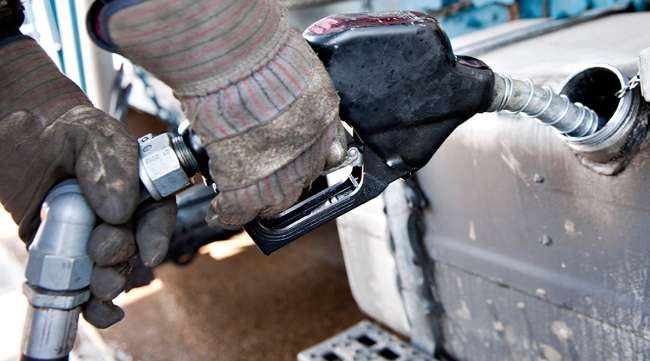Senior Reporter
Diesel Increases by a Penny; Gas Climbs Back Above $2

[Stay on top of transportation news: Get TTNews in your inbox.]
The nationwide average price of a gallon of diesel increased by 1 cent to $2.396, according to the weekly report from the Energy Information Administration on June 8.
Still, the trucking industry’s primary fuel is 70.9 cents a gallon less expensive than the same week last year. Gasoline, meanwhile, marched back above $2 with a weekly increase of 6.2 cents to reach $2.036, still 69.6 cents cheaper than a year ago. Gasoline had been below $2 since April 6.
Diesel increased in all 10 of the regions surveyed by EIA, with a rise of only 0.1 cent in the Gulf Coast to $2.172. Home to much of the nation’s petroleum and refining industry, the Gulf Coast has the least expensive diesel in the nation, in part because of lower transportation and storage costs there. The diesel in that area is 67.1 cents cheaper than last spring.
U.S. average on-highway #diesel fuel price on 6/08/2020 was $2.396/gal, UP 1.0¢/gallon from 6/01/2020, DOWN 70.9¢/gallon from year ago https://t.co/rXDU5IIzOq #truckers #shippers #fuelprices pic.twitter.com/7eP9wkeNOc — EIA (@EIAgov) June 9, 2020
The most significant increase came in the West Coast, which saw a jump of 1.8 cents. A gallon of diesel there costs $2.918, but that is 79.7 cents per gallon less expensive than a year ago.
Meanwhile, U.S. officials are praising members of the oil-producing nations, Organization of Petroleum Exporting Countries and others, collectively known as OPEC+, after they agreed June 6-7 to extend their initial oil production cuts for at least another month, slashing daily production by an estimated 10 million barrels of oil.
The cuts were first imposed in April after Russia and Saudi Arabia throughout the winter refused to cut production, and the world economy cratered because of the coronavirus pandemic, creating a glut of oil in global markets.
U.S. Secretary of Energy Dan Brouillette expressed support in a tweet June 6.
“I applaud OPEC+ for reaching an important agreement today, which comes at a pivotal time as oil demand continues to recover, and economies reopen around the world,” he said.
West Texas Intermediate oil, the industry benchmark, fell $1.37 per barrel June 8 to close at $38.13. WTI’s 52-week high was $65.65.
Oil industry analyst Phil Flynn, a senior market analyst with the Price Futures Group in Chicago, told Transport Topics that the extension of the production cuts is more than window dressing and could stabilize world oil prices.
“The reason they were able to extend production cuts is that they got promises from all of the producers they would be on their best behavior,” Flynn said.
According to Baker Hughes’ rig count, oil and natural gas exploration plummeted as the number of active rigs dropped 70.8% from 975 platforms a year ago to 284 on June 7. Baker Hughes said this is the 13th week in a row that the count has dropped.
U.S. average price for regular-grade #gasoline on 6/08/2020 was $2.036/gal, UP 6.2¢/gallon from 6/01/2020, DOWN 69.6¢/gallon from year ago https://t.co/HPxV9hrSzk #gasprices pic.twitter.com/Zdd1O97mhm — EIA (@EIAgov) June 9, 2020
The number of operating rigs in Texas fell to 115 from 473 in 2019. In New Mexico, it went to 58 from 101. North Dakota dropped to 12 from 56, Pennsylvania to 20 from 39, Louisiana to 34 from 101 and Oklahoma to 11 from 101.
Baker Hughes, No. 73 on the Transport Topics Top 100 list of the largest private carriers in North America, said its active rig count is a leading indicator of demand for products used in drilling, completing, producing and processing hydrocarbons.
Flynn said oil producers are operating only the most productive rigs to save cash.
RELATED: Oil Erases Gains With Saudis Ending Extra Output Cuts
“Domestic production is going to be down for a while,” he said. “They’re focusing on their best wells, and some of the wells that don’t produce will be capped. If you’re going to be spending money, you’re going to want to get a quick return on your dollar, so you’re going to use your best wells, the cheapest ones to produce.”

How can trucking companies adjust to ensure that essential freight keeps moving while protecting their workers from coronavirus? Host Seth Clevenger speaks with Lilli Chiu of Hub International and Dave Cox of Polaris Transportation. Hear a snippet, above, and get the full program by going to RoadSigns.TTNews.com.
According to research from the American Transportation Research Institute, truck speeds have noticeably increased during the pandemic because fewer vehicles are on the highways and roads.
For example, in late March along Interstate 495 in Queens, N.Y., the average speed more than doubled from 16 mph to 38 mph, although that’s still well below the posted speed.
The speeds are collected from GPS data from more than a million trucks, according to ATRI.
Mike Roeth, executive director of the North American Council for Freight Efficiency, told Transport Topics that even as diesel prices have plunged, some trucking companies are paying about the same for fuel as they were before the pandemic. That’s because they are using more fuel to go faster.
“Truck speeds are up. In an ELD world, truckers and fleets want the trucks and the freight to get there as fast as they can,” Roeth said. “These trucks are driving faster, and they’re burning more fuel to get there. No matter how aerodynamic a truck is, speed kills fuel efficiency.”
Want more news? Listen to today's daily briefing:
Subscribe: Apple Podcasts | Spotify | Amazon Alexa | Google Assistant | More




